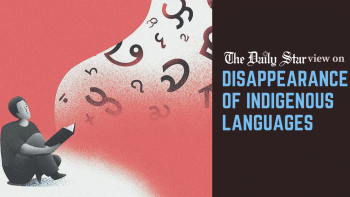Preserving the uncharted

Laleng, an Indigenous tongue, is attributed to the Patro community who inhabit the culturally rich environs of Sylhet Sadar, Jaintiapur, and Gowainghat areas within the geographical boundaries of Bangladesh. Deeply rooted in traditional Hindu customs and practices, the Patro community holds historical significance dating back to the British colonial era. During their rule, the British conducted surveys to gather information about various communities and their languages, but when it came to the Patro community, they figuratively closed the door behind them, resulting in a significant knowledge gap regarding the Patro people and their language within the wider population. This lack of awareness isolated the Patro community from the broader society, leaving them somewhat disconnected.
In the past, Laleng speakers within Patro society exhibited a pronounced conservatism, holding the belief that their language should be safeguarded from widespread use as a means of communication with outsiders. This protective stance aimed to maintain the exclusivity of Laleng, preserving its uniqueness and cultural identity.
As a result, Laleng remains shrouded in anonymity as it belongs to a linguistically unclassified family. Many language specialists have conjectured that Laleng may be affiliated with the Sino-Tibetan language family. However, despite extensive research by language specialists, where Laleng belongs remains elusive. This enigma adds to Laleng's allure, highlighting the intricate nature of language evolution and diversity within the broader linguistic landscape.
There has been a disconcerting and precipitous decline in the numerical strength of the Patro, once a flourishing race. With approximately 6,000 speakers of Laleng, this decline jeopardises the very fabric of their linguistic heritage and collective identity. As their ranks dwindle, the vibrant Laleng language teeters on the brink of irretrievable loss.
Moreover, relentless advance of globalisation and the ever-evolving sociocultural landscape have gradually led to limited intergenerational transmission of Laleng. The young generations, primarily influenced by the medium of instruction in Bangla and English during their educational journey, find themselves utilising Laleng in a restricted manner. Regrettably, even within the confines of their homes, they relinquish the opportunity to engage with their parents in their native language. This decline extends beyond linguistic loss, posing a threat to the community's identity and knowledge systems passed down through generations.
This worrisome trend highlights an alarming decline in prominence and prevalence of Laleng within the Patro community. The impact of these transformative forces underscores the urgent need to address the challenges facing the preservation and revitalisation of Laleng as a crucial component of the Patro cultural heritage.
To counter this, Laleng speakers and their affiliated organisation have undertaken several proactive initiatives aimed at the preservation of their language and culture. They are fostering a supportive environment where the use of their native language within their own community is actively encouraged.
The relentless advance of globalisation and the ever-evolving sociocultural landscape have gradually led to limited intergenerational transmission of Laleng. The young generations, primarily influenced by the medium of instruction in Bangla and English during their educational journey, find themselves utilising Laleng in a restricted manner.
Furthermore, within the framework of the Enhancement of Bangla Language in ICT through Research and Development (EBLICT) initiative, an integral component known as the Digitisation of Ethnic Languages in Bangladesh has emerged. This commendable endeavour, spearheaded by the Bangladesh Computer Council and the ICT Division, with the executory organisation Dream71 Bangladesh Limited, aims to amass an extensive digital repository of 40 ethnic languages in Bangladesh.
This ambitious undertaking embarks on a transformative journey of archiving the Laleng language, particularly focusing on its unique sound system. By meticulously collecting and documenting the intricate details of Laleng's sound patterns, this project seeks to create an invaluable resource for future generations, ensuring the enduring legacy of the Laleng language and its rich cultural heritage.
Within the realm of this project, Laleng possesses an inherent exploratory nature, particularly when it comes to the intricacies of its sound patterns. Given Laleng's yet-not-to-be-determined linguistic affiliation within a language family, there exists an opportunity to unveil the extent to which its phonetic characteristics align, whether the sounds are aligned with those of the Sino-Tibetan languages or not, as well as its underlying structural foundations. The burning question here pertains to the distinct language structure that vividly influences the development of Laleng. To comprehend this, a thorough exploration of both synchronic and diachronic aspects is imperative, as words are subject to change while structure necessitates investigation. All of these might be the aspect of future research.
Operating within this comprehensive framework, an extensive audio repository of linguistic data has been meticulously compiled for Laleng, encompassing a substantial collection of 300 minutes dedicated to words and grammar, and both predefined and spontaneous expressions. This ambitious endeavour aims at fostering an invaluable resource for Laleng speakers to revisit and rekindle their connection with their language and rich cultural heritage.
Laleng, the language spoken by the Patro community, holds within its depths a treasure trove of untold stories that offer a profound glimpse into their vibrant culture. To unveil this wealth of linguistic heritage to the world, a meticulous process of International Phonetic Alphabet (IPA) transcription is currently underway. This endeavour will infuse the spoken essence of the Laleng language with renewed vitality, propelling it towards the realm of modernity and technological progress. By embracing this transformative journey, Laleng's narrative will transcend the confines of the past, emerging as a beacon of cultural richness that resonates with both present and future generations.
Khairun Nahar Ipshita is a researcher.
Views expressed in this article are the author's own.
Follow The Daily Star Opinion on Facebook for the latest opinions, commentaries and analyses by experts and professionals. To contribute your article or letter to The Daily Star Opinion, see our guidelines for submission.

 For all latest news, follow The Daily Star's Google News channel.
For all latest news, follow The Daily Star's Google News channel. 








Comments